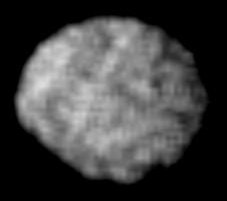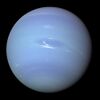Astronomy:Larissa (moon)
 Larissa from Voyager 2 | |
| Discovery | |
|---|---|
| Discovered by | Harold J. Reitsema, William B. Hubbard, Larry A. Lebofsky, and David J. Tholen[1] |
| Discovery date | May 24, 1981 |
| Designations | |
Designation | Neptune VII |
| Pronunciation | /ləˈrɪsə/[2] |
| Named after | Λάρισσα Lārissa |
| S/1989 N 2 S/1981 N 1 | |
| Adjectives | Larissean,[3] Larissan,[4] Larissian[5] /ləˈrɪs(i)ən/ |
| Orbital characteristics[6][7] | |
| Epoch 18 August 1989 | |
| 73 548.26 km | |
| Eccentricity | 0.001393 ± 0.00008 |
| Orbital period | 0.55465332 ± 0.00000001 d |
| Inclination |
|
| Satellite of | Neptune |
| Physical characteristics | |
| Dimensions | 216 × 204 × 168 km (± ~10 km)[8][9] |
| Mean radius | 97 ± 5.4 km[7] |
| Surface area | 118,236.98 km2[10] |
| Volume | ~3.5×106 km³ |
| Mass | ~4.2×1018 kg (estimate)[lower-alpha 1] |
| Mean density | ~1.2 g/cm3 (estimate)[12] |
| ~0.03 m/s2[lower-alpha 2] | |
| ~0.076 km/s[lower-alpha 3] | |
| Rotation period | synchronous |
| Axial tilt | zero |
| Albedo | 0.09[8][12] |
| Physics | ~51 K mean (estimate) |
| Apparent magnitude | 21.5[12] |
Larissa, also known as Neptune VII, is the fifth-closest inner satellite of Neptune. It is named after Larissa, a lover of Poseidon (Neptune) in Greek mythology and eponymous nymph of the city in Thessaly, Greece.
Discovery
It was first discovered by Harold J. Reitsema, William B. Hubbard, Larry A. Lebofsky and David J. Tholen, based on fortuitous ground-based stellar occultation observations[13] on May 24, 1981, given the temporary designation S/1981 N 1 and announced on May 29, 1981.[14] The moon was recovered and confirmed to be the only object in its orbit during the Voyager 2 flyby in 1989[15] after which it received the additional designation S/1989 N 2 on August 2, 1989.[16] The announcement by Stephen P. Synnott spoke of "10 frames taken over 5 days", which gives a recovery date sometime before July 28. The name was given on September 16, 1991.[17]
Characteristics
The fourth-largest satellite of Neptune, Larissa is irregular (non-spherical) in shape and appears to be heavily cratered, with no sign of any geological modification. It is likely that Larissa, like the other satellites inward of Triton, is a rubble pile re-accreted from fragments of Neptune's original satellites, which were disrupted by perturbations from Triton soon after that moon's capture into a very eccentric initial orbit.[18]
Larissa's orbit is nearly circular and lies below Neptune's synchronous orbit radius, so it is slowly spiralling inward due to tidal deceleration and may eventually impact Neptune's atmosphere, or break up into a planetary ring upon passing its Roche limit due to tidal stretching, similarly to how Triton will eventually collide with Neptune or break into a planetary ring.
Exploration
Larissa has only been visited by Voyager 2.[19] The probe was able to get photographs of Larissa, showing its cratered surface.
Notes
- ↑ The mass estimate is based on the assumed density of 1.2 g/cm3, and a volume of 3.5 ×106 km³ obtained from a detailed shape model in Stooke (1994).[11]
- ↑ Surface gravity derived from the mass m, the gravitational constant G and the radius r: Gm/r2.
- ↑ Escape velocity derived from the mass m, the gravitational constant G and the radius r: √2Gm/r.
References
- ↑ "Larissa In Depth". https://solarsystem.nasa.gov/moons/neptune-moons/larissa/in-depth/.
- ↑ "Larissa". Merriam-Webster Dictionary. https://www.merriam-webster.com/dictionary/Larissa.
- ↑ Boccaccio (1974) The book of Theseus
- ↑ Livy (1850 trans.) The history of Rome, v. 3
- ↑ Bell (1790) Bell's New pantheon
- ↑ Jacobson, R. A.; Owen, W. M. Jr. (2004). "The orbits of the inner Neptunian satellites from Voyager, Earthbased, and Hubble Space Telescope observations". Astronomical Journal 128 (3): 1412–1417. doi:10.1086/423037. Bibcode: 2004AJ....128.1412J.
- ↑ 7.0 7.1 Showalter, M. R.; de Pater, I.; Lissauer, J. J.; French, R. S. (2019). "The seventh inner moon of Neptune". Nature 566 (7744): 350–353. doi:10.1038/s41586-019-0909-9. PMID 30787452. PMC 6424524. Bibcode: 2019Natur.566..350S. https://www.spacetelescope.org/static/archives/releases/science_papers/heic1904/heic1904a.pdf.
- ↑ 8.0 8.1 Karkoschka, Erich (2003). "Sizes, shapes, and albedos of the inner satellites of Neptune". Icarus 162 (2): 400–407. doi:10.1016/S0019-1035(03)00002-2. Bibcode: 2003Icar..162..400K.
- ↑ Williams, Dr. David R. (2008-01-22). "Neptunian Satellite Fact Sheet". NASA (National Space Science Data Center). http://nssdc.gsfc.nasa.gov/planetary/factsheet/neptuniansatfact.html.
- ↑ "Larissa In Depth". https://solarsystem.nasa.gov/moons/neptune-moons/larissa/by-the-numbers/.
- ↑ Stooke, Philip J. (1994). "The surfaces of Larissa and Proteus". Earth, Moon, and Planets 65 (1): 31–54. doi:10.1007/BF00572198. Bibcode: 1994EM&P...65...31S.
- ↑ 12.0 12.1 12.2 "Planetary Satellite Physical Parameters". JPL (Solar System Dynamics). 2010-10-18. http://ssd.jpl.nasa.gov/?sat_phys_par.
- ↑ Reitsema, Harold J.; Hubbard, William B.; Lebofsky, Larry A.; Tholen, David J. (1982). "Occultation by a Possible Third Satellite of Neptune". Science 215 (4530): 289–291. doi:10.1126/science.215.4530.289. PMID 17784355. Bibcode: 1982Sci...215..289R.
- ↑ Marsden, Brian G. (May 29, 1981). "S/1981 N 1". IAU Circular 3608. http://www.cbat.eps.harvard.edu/iauc/03600/03608.html. Retrieved 2011-10-26.
- ↑ Smith, B. A.; Soderblom, L. A.; Banfield, D.; Barnet, C.; Basilevsky, A. T.; Beebe, R. F.; Bollinger, K.; Boyce, J. M. et al. (1989). "Voyager 2 at Neptune: Imaging Science Results". Science 246 (4936): 1422–1449. doi:10.1126/science.246.4936.1422. PMID 17755997. Bibcode: 1989Sci...246.1422S. https://zenodo.org/record/1230992. [on page 1435]
- ↑ Marsden, Brian G. (August 2, 1989). "Satellites of Neptune". IAU Circular 4824. http://www.cbat.eps.harvard.edu/iauc/04800/04824.html. Retrieved 2011-10-26.
- ↑ Marsden, Brian G. (September 16, 1991). "Satellites of Saturn and Neptune". IAU Circular 5347. http://www.cbat.eps.harvard.edu/iauc/05300/05347.html. Retrieved 2011-10-26.
- ↑ Banfield, Don; Murray, Norm (October 1992). "A dynamical history of the inner Neptunian satellites". Icarus 99 (2): 390–401. doi:10.1016/0019-1035(92)90155-Z. Bibcode: 1992Icar...99..390B.
- ↑ "Larissa Facts". https://www.factsjustforkids.com/planet-facts/neptune-facts-for-kids/larissa-moon-facts.html.
External links
- Larissa Profile by NASA's Solar System Exploration
- Neptune's Known Satellites (by Scott S. Sheppard)
 |





